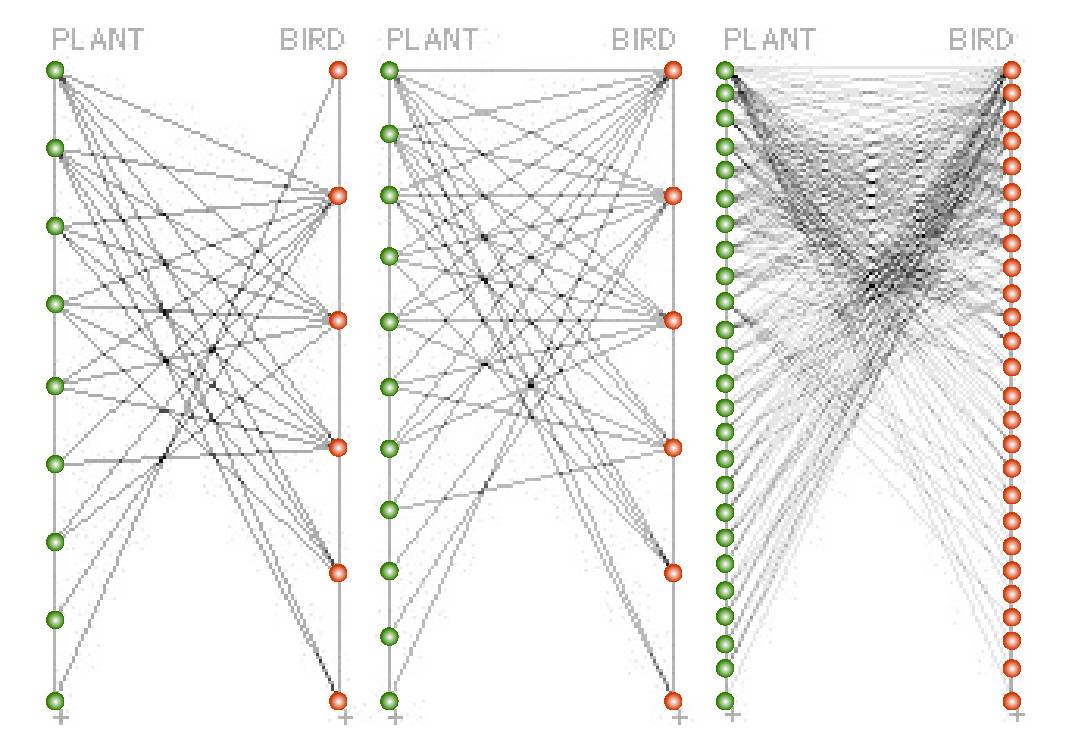Jordano, P. 1987. Patterns of mutualistic interactions in pollination and seed dispersal: connectance, dependence asymmetries, and coevolution. American Naturalist 129: 657-677.
 Patterns of connectance and strength of mutual dependence in mutualisms have been examined by comparing the fraction of possible pairwise interactions established in a series of plant-pollinator and plant-seed disperser systems. As the number of species in the mutualistic system increases, the absolute number of interactions established increases, but connectance decreases exponentially. A given increase in diversity adds twice the number of interactions to dispersal systems as to pollination systems, suggesting a higher global specificity of the latter. Connectance patterns in mutualisms are analogous to some of those observed in complex food webs, suggesting a somewhat invariant structure in the relations between sets of interacting species. For seed dispersal systems involving frugivorous birds, mutual dependence values are strongly skewed toward the low end and illustrate generally strong asymmetries in mutualistic interactions. These patterns may be expected by considering simple multiplicative effects within multispecies assemblages as a result of variations in the number of species and in the underlying abundance distributions of the species involved. Coadaptation may originate from a process of species sorting without the necessity of genetic (coevolved) changes. Asymmetrical interactions and the prevalence of weak relations can provide pathways for rare species to persist and alternative routes for system responses to perturbations. These findings emphasize the diffuse nature of coevolution in mutualistic webs and suggest a mode by which diffuse coevolution can proceed.
Patterns of connectance and strength of mutual dependence in mutualisms have been examined by comparing the fraction of possible pairwise interactions established in a series of plant-pollinator and plant-seed disperser systems. As the number of species in the mutualistic system increases, the absolute number of interactions established increases, but connectance decreases exponentially. A given increase in diversity adds twice the number of interactions to dispersal systems as to pollination systems, suggesting a higher global specificity of the latter. Connectance patterns in mutualisms are analogous to some of those observed in complex food webs, suggesting a somewhat invariant structure in the relations between sets of interacting species. For seed dispersal systems involving frugivorous birds, mutual dependence values are strongly skewed toward the low end and illustrate generally strong asymmetries in mutualistic interactions. These patterns may be expected by considering simple multiplicative effects within multispecies assemblages as a result of variations in the number of species and in the underlying abundance distributions of the species involved. Coadaptation may originate from a process of species sorting without the necessity of genetic (coevolved) changes. Asymmetrical interactions and the prevalence of weak relations can provide pathways for rare species to persist and alternative routes for system responses to perturbations. These findings emphasize the diffuse nature of coevolution in mutualistic webs and suggest a mode by which diffuse coevolution can proceed.
| Photo: Interaction networks of fruiting plants and frugivorous birds. |